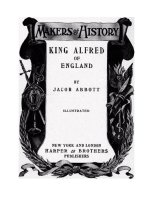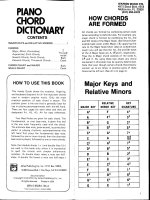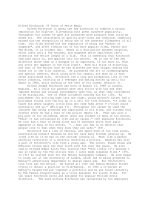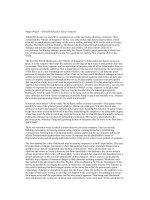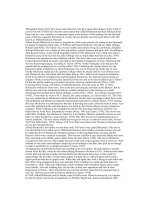Gene adair alfred hitchcock ~ filming our fears
Bạn đang xem bản rút gọn của tài liệu. Xem và tải ngay bản đầy đủ của tài liệu tại đây (521.7 KB, 161 trang )
Alfred Hitchcock:
Filming Our Fears
Gene Adair
OXFORD UNIVERSITY PRESS
Alfred Hitchcock
Filming Our Fears
Image Not Available
Alfred Hitchcock
Filming Our Fears
Gene Adair
1
To my mother and the memory of my father
1
Oxford New York
Auckland Bangkok Buenos Aires Cape Town Chennai Dar es Salaam Delhi
Hong Kong Istanbul Karachi Kolkata Kuala Lumpur Madrid Melbourne Mexico
City Mumbai Nairobi São Paulo Shanghai Singapore Taipei Tokyo Toronto
and an associated company in Berlin
Copyright © 2002 by Gene Adair
Published by Oxford University Press, Inc.
198 Madison Avenue, New York, New York 10016
www.oup.com
Oxford is a registered trademark of Oxford University Press
All rights reserved. No part of this publication may be reproduced,
stored in a retrieval system, or transmitted in any form by any means,
electronic, mechanical, photocopying, recording, or otherwise,
without the prior permission of Oxford University Press.
Design: Greg Wozney
Layout: Lynn Serra
Picture Research: Lisa Barnett
Library of Congress Cataloging-in-Publication Data
Adair, Gene.
Alfred Hitchcock : filming our fears / Gene Adair.
v. cm.
Includes bibliographical references and index.
Contents: 1. The grocer's son from Leytonstone -- 2. A filmmaker's
apprenticeship -- 3. From silents to sound -- 4. Highs and lows -- 5.
England's leading film director -- 6. America calling -- 7. An
Englishman in Hollywood -- 8. The war years and beyond -- 9. Gaining
independence -- 10. A new contract with Paramount -- 11. Three
masterpieces -- 12. A new home at Universal -- 13. Last years and
legacy.
ISBN 0-19-511967-3 (alk. paper)
1. Hitchcock, Alfred, 1899- 2. Motion picture producers and
directors--Great Britain--Biography. [1. Hitchcock, Alfred, 1899- 2.
Motion picture producers and directors.] I. Title.
PN1998.3.H58 A728 2002
791.43'0233'092--dc21
2002000695
987654321
Printed in the United States of America
on acid-free paper
On the cover: The Master of Suspense composes a shot
Frontispiece: Alfred Hitchcock on the set at Paramount during the 1950s
C ONTENTS
PREFACE: THE SHOWMAN AND THE ARTIST
6
1 THE GROCER’S SON FROM LEYTONSTONE
11
2 A FILMMAKER’S APPRENTICESHIP
21
3 FROM SILENTS TO SOUND
28
Hitchcock on the English Taste for Crime 30
4 HIGHS AND LOWS
40
5 ENGLAND’S LEADING FILM DIRECTOR
48
Hitchcock on Suspense 52
6 AN ENGLISHMAN IN HOLLYWOOD
64
7 THE WAR YEARS AND BEYOND
75
8 GAINING INDEPENDENCE
87
9 A NEW CONTRACT WITH PARAMOUNT
99
Hitchcock on Direction 100
10 THREE MASTERPIECES
112
Hitchcock on Actors 121
11 A NEW HOME AT UNIVERSAL
127
12 LAST YEARS AND LEGACY
137
CHRONOLOGY
FURTHER READING
FILMS DIRECTED BY ALFRED HITCHCOCK
INDEX
148
150
152
154
P REFACE :
T HE S HOWMAN AND
THE A RTIST
It is a warm evening in the late spring of 1960. Film fans
across America flock into theaters and settle into their seats,
munching popcorn as they wait for the lights to dim. In
each of these movie houses the ritual is the same. The main
feature does not begin right away. Instead, an assortment of
“trailers”—short promotional films touting the theater’s
“coming attractions”—fill the screen. These trailers consist
mostly of brief snippets from whatever movie is being
advertised. The bits of action and dialogue are usually combined with some breathless narration from an unseen
announcer, while an array of boldly lettered phrases appear
over the images, emphasizing adjectives like “exciting,”
“romantic,” or “spectacular.”
On this particular evening, however, one trailer stands
out as different from the others. Filmed in black and white,
it begins with a wide view of a small, drab motel. A portly
man, wearing a dark suit, white shirt and tie, stands in front
of the building. Words are superimposed: “The fabulous
Mr. Alfred Hitchcock is about to escort you on a tour of
the location of his new motion picture, ‘PSYCHO.’” But
even without this information, the audience would have no
trouble recognizing Hitchcock. His round frame, balding
head, and distinctive British-accented drawl are instantly
familiar from the television mystery series that he hosts
every week on the CBS network. Besides, he has long
enjoyed a reputation as the movies’ “Master of Suspense”—
the director of many elegantly crafted thrillers dating back
to the 1920s.
6
P R E FAC E : T H E S H OW M A N A N D T H E A RT I S T
As the trailer proceeds,
Hitchcock tells the audience
that the motel behind him
might appear to be harmless
but that it “has now become
known as the scene of the
Image Not Available
crime.” He pauses for an
instant to let that ominous
fact sink in. Next, he points
out another building, this
one an old Victorian house
that sits atop a hill behind
the motel. It is, he says, “a little more sinister-looking, less
Psycho star Anthony
Perkins stands beside
innocent than the motel itself,” and it was there that “the
the sinister-looking
most dire, horrible events took place.”
house that was one of
the film’s principal sets.
“I think we can go inside,” the filmmaker adds, “because
According to Hitchcock,
the place is up for sale—although I don’t know who’s going
the appearance of the
to buy it now.”
house was true to the
film’s setting: “The
The tour of the house includes a view of the staircase—
actual locale of the
the scene of a murder whose ghastly details elicit a mock shudevents is in northern
California, where that
der from Hitchcock—and a visit to the second-floor bedroom
type of house is very
where a certain “maniacal woman” lived. “I think some of her
common.”
clothes are still in the wardrobe,” Hitchcock remarks.
Now it is back to the motel and the parlor behind its
office—“the favorite spot,” we are told, of the woman’s son,
a young man “you had to feel sorry for.”
Hitchcock notes that the son’s hobby was taxidermy—
“a crow here, an owl there”—and that “an important scene
took place in this room.” Yet, he hints, something even
more important took place in “Cabin Number One.” And
that, of course, is where he takes the audience for the last
stop on his little tour.
Inside the bathroom of the motel cabin, Hitchcock
observes, “All tidied up . . . Big difference. You should have
seen the blood. The whole place was, well, it’s too horrible
to describe. Dreadful.” Moving toward the shower curtain,
7
ALFRED HITCHCOCK
Hitchcock continues: “The murderer, you see, crept in here
very silently. . . . The shower was on—there was no sound,
and . . . ” Hitchcock flings open the curtain. Cut to a
close-up of a woman screaming as a violin shrieks on the
soundtrack. The title “PSYCHO” flashes on the screen,
and the letters split jaggedly apart.
So began the advertising campaign for what would
become the most famous thriller in film history. The unusual,
six-minute trailer for Psycho, playing off Hitchcock’s public
image as something of a macabre comedian, was hardly the
only item in his promotional bag of tricks. To emphasize the
story’s shocking twists, the director insisted that Psycho must
be seen “from the beginning”; when the film opened that
summer, patrons were refused admission if they showed up at
the theater after the feature had started. This policy extended
even to critics. Accustomed to viewing movies in special
screenings before their release to the general public, newspaper and magazine reviewers were forced to see Psycho as part
of the regular audience.
Such promotional tactics may have been a bit gimmicky,
but they certainly sparked moviegoers’ desire to see Psycho.
And the film itself obviously did not let them down, for it
soon became the most commercially successful of all
Hitchcock’s films. Unfortunately, the teasing showmanship
that was used to publicize the picture also reinforced the opinion of many at the time that its maker was only a showman,
an entertainer and nothing more. It was widely taken for
granted that no serious artist would work in the crime-andsuspense genre. Certainly no artist would even consider
making something as horrific as Psycho and then go about
promoting it in such a frivolous way.
Viewpoints change, however. In the four decades since
Psycho’s release, countless critics have declared it a key work by
a master filmmaker. Its unsettling power and expert technique
have inspired hundreds of pages of critical analysis, and it
remains among the movies most commonly taught in film
8
P R E FAC E : T H E S H OW M A N A N D T H E A RT I S T
courses. Over the years, its combination of violence, sex, and
psychological horror, daring for 1960, has inspired dozens of
imitations—usually turned out by directors of far less talent,
wit, and vision than Alfred Hitchcock.
Before his death in 1980, Hitchcock made a total of 53
feature films. In addition to Psycho, his works include such
suspense classics as The 39 Steps, The Lady Vanishes, Shadow of
a Doubt, Notorious, Rear Window, Vertigo, North by Northwest,
and The Birds. The director often suggested that his talent for
stirring audiences’ anxieties came from the fact that he himself was full of fears. He claimed to be terrified of getting so
much as a traffic ticket, and he maintained an unusually cautious way of living—always following rigid daily routines,
always staying in the same hotels and dining in the same
restaurants, always claiming that his vision of happiness was a
clear, uninterrupted horizon.
Yet despite his devotion to routine and stability, in his
work he was ever willing to take on new technical challenges, and his contributions to the ways in which stories are
told on film are immeasurable. His ways of composing
images, of moving the camera, of placing one shot next to
another—all designed to grip his viewers and stir their emotions—were truly masterful.
In his public statements, Hitchcock often lent support to
those who saw him only as an entertainer. He frequently said
that technique and style were his real interests, that he cared
nothing for “content.” And yet this claim is contradicted by
the films themselves, which show remarkable consistency, over
the course of a 50-year career, in their concern with the conflicts between guilt and innocence, trust and suspicion, reality
and illusion, order and chaos.
Showman or artist? Alfred Hitchcock was both.
9
Image Not Available
William Hitchcock and his youngest child, Alfred, strike a formal pose outside the family grocery. The
future movie director was about seven at the time.
C H A P T E R
1
T HE G ROCER ’ S S ON
FROM L EYTONSTONE
Alfred Joseph Hitchcock was born on August 13, 1899, in
Leytonstone, England, a community on the northeastern
edge of London. His father, William Hitchcock, operated a
retail and wholesale grocery business specializing in fruits
and vegetables. The rooms above the family shop served as
living quarters. It was there, at 517 The High Road, that
Alfred was born and spent his earliest years under the
watchful eye of his mother, Emma.
At the time of Alfred’s birth, the family business was
thriving, a benefit that came with the area’s swelling population. Located about six miles from central London,
Leytonstone had once been a sleepy country village well
removed from the bustle of the British capital, but that was
rapidly changing. Through much of the 19th century,
London underwent extraordinary growth. In the 1820s, its
population had numbered 1.5 million; by the end of the
century, “Greater London”—the core city and surrounding
suburbs—contained some 6.5 million inhabitants. Towns
like Leytonstone were engulfed by this ever-widening urban
sprawl, which some likened to a “cancer” on the face of
England. To others, however, London’s expansion was part
11
ALFRED HITCHCOCK
of what made it an endlessly exciting place, a center of culture
and activity. Its diverse economy encompassed everything
from clothing manufacture to metalworking, from furnituremaking to food-processing. And it boasted the world’s largest
and busiest port. Each day, docks on the River Thames
witnessed the heavy traffic of ships bearing goods to and from
Britain’s far-flung colonies and other distant lands.
It was a great city where many fortunes were made but
also one where thousands lived in poverty or just above the
poverty line. The Hitchcock family fell between the
extremes of wealth and destitution. As small shopkeepers,
they were hardly rich but certainly better off than many of
their neighbors. London’s East End, of which Leytonstone
was fast becoming a part, was home to many of the poorer
people who had swarmed into the city from other parts of
England, from Ireland, and from eastern Europe. Searching
for a better life, these people often found subsistence wages
and wretched, overcrowded housing.
Escaping that hard lot, William and Emma Hitchcock
maintained a well-ordered household in which they tried to
shelter their children from the harsher realities of life that lay
not far from their own doorstep. They were, by all accounts,
decent, reserved, hardworking sorts—a typical lowermiddle-class English couple in many ways. In one respect,
however, they were unusual. In a predominantly Protestant
country, they were staunch Roman Catholics. Attending
Mass on Sunday was a regular feature of their family life.
Alfred was the youngest of William and Emma’s three
children. His two older siblings—William Jr., born in 1890,
and Ellen Kathleen (or, as the family called her, “Nellie”),
born in 1892—were away at school during much of his
growing up. As a result, he never grew close to either of
them. Nor did he share the company of children his own
age. Pudgy, shy, and unusually quiet, he preferred to amuse
himself in solitary games. As he got older, these activities
included studying maps, memorizing the schedules of trains
12
T H E G RO C E R ’ S S O N F RO M L E Y T O N S T O N E
and streetcars, and keeping a large wall chart for plotting
the positions of British ships around the world.
When Alfred ventured outside the house, it was often
to join his father on outings for the family business.
Together they would ride a horse-drawn cart through the
streets of Leytonstone and the neighboring communities,
delivering produce to various customers. At other times,
Alfred accompanied William on purchasing tr ips. “I
remember as a child going with him into the countryside,
and he would buy a whole field of cabbages,” he recalled.
Such excursions were the source of happy memories,
but one experience involving his father was not so pleasant.
Hitchcock would recount this incident for decades afterward. It happened, he said, when he was about five years
old. To punish him for some minor misdeed, his father sent
him off to the local police station with a note. Trembling, little Alfred handed the scrap of paper to the officer in charge,
who read its instructions, led the boy down a corridor, and
locked him in a jail cell for several minutes. “This is what we
do to naughty boys!” the policeman warned him sternly.
From that single episode, Hitchcock would claim, arose
a lifelong terror of the police. It was a terror that would
Image Not Available
At the Leytonstone
police station,
Hitchcock claimed, he
came to know fear firsthand. To punish him
for being “naughty,”
his father had an officer
place him in a cell for
a few minutes. “It
must be said to my
credit,” Hitchcock once
remarked, “that I
never wanted to be
a policeman.”
13
ALFRED HITCHCOCK
surface time and again in his films, especially those in which
the main character is falsely accused of a crime and pursued
by the authorities. Whether the incident actually occurred,
or whether it was just a colorful fiction that Hitchcock trotted out for interviewers, is impossible to say. Still, the story
does suggest that the emotions of fear and anxiety loomed
large in his earliest memories.
While strict in their churchgoing and their childrearing
methods, the Hitchcocks did enjoy occasional evenings out.
Even before he started school, Alfred accompanied his parents to plays and variety shows. These experiences gave him
a deep love of the theater and its glamorous world of makebelieve, a love that no doubt helped lead him to a career in
movies. And, like his professed fear of the police, this affection for playgoing had an obvious influence on the content
of his films. Scenes with theatrical settings would be sprinkled throughout his movies, and even more subtly, the
influence would affect his characterizations. In many a
Hitchcock film, characters engage in role-playing of one
sort or another and are often not what they appear to be.
The family moved from Leytonstone to other parts of the
East End—to Poplar in 1907 and then to Stepney in 1909—as
William Hitchcock expanded his business and opened new
shops. To the fruit-and-vegetable stores he already operated,
he added a shop selling fresh fish. Thus, when Alfred entered
the St. Ignatius College in 1910 (after briefly attending a couple of other Catholic schools), his father’s profession was listed
as “fishmonger” on the enrollment forms.
St. Ignatius, though called a college, was actually what
Americans know as a secondary school. It was located in
London’s Stamford Hill district and run by Jesuit priests.
The Jesuits were noted for their rigorous approach to education, and this included their methods of discipline. Corporal
punishment—usually consisting of raps to the knuckles with
a hard-rubber cane—was administered regularly. This environment reinforced Alfred’s fear of authority. Of the school’s
14
T H E G RO C E R ’ S S O N F RO M L E Y T O N S T O N E
punishments, he remembered, “It
wasn’t done casually, you know. . . .
They would tell you to step in and
see the father when classes were over.
He would then solemnly inscribe
your name in the register, together
with the indication of the punishment
to be inflicted, and you spent the
Image Not Available
whole day waiting for the sentence to
be carried out.”
By most accounts, Alfred was only
an average, or slightly above-average,
student. At age 12, however, after
completing his first year at St. Ignatius,
he was one of several pupils singled out
for special achievement in Latin,
English, French, and religious educaWhen Hitchcock was
tion. None of these was his favorite subject, however. That
a teenager, going to
subject, in line with his love of maps and timetables, was
movies and reading film
geography. But the most valuable lessons he took from the
journals became two of
his favorite pastimes.
Jesuits had less to do with specific areas of study than with
their overall approach to life and learning. “The Jesuits taught
me organization, control, and, to some degree, analysis,” he
said. “Their education is very strict, and orderliness is one of
the things that came out of that.”
Alfred left St. Ignatius in the summer of 1913. At this
point, he recalled, his parents asked him what profession he
wanted to pursue. For lack of a better idea, he said that he
wished to become an engineer, and soon William and Emma
had him taking evening classes in the School of Engineering
and Navigation at the University of London. He studied
mechanics, electricity, acoustics, and navigation but was not
enrolled in any degree program.
The question of a career became more urgent when
Alfred’s father, who had been in poor health for some time,
died in December 1914. Alfred was the only child left at
15
ALFRED HITCHCOCK
home. His sister had married, and William Jr., who inherited the family business, was on his own as well. To help support himself and his mother, Alfred took a job early in 1915
as a technical clerk at the Henley Telegraph and Cable
Company. He had not yet reached his 16th birthday. It is
likely that around this time, he and his mother went back to
Leytonstone, perhaps to be closer to friends and family.
The Henley firm manufactured electrical cable, and
young Hitchcock worked there for about four years.
Eventually he became an estimating clerk. This job involved
calculating the sizes and voltages of electrical cables needed for
particular installations. The work bored him, and he later
admitted that he was not especially dedicated to it. He tended
to procrastinate when requests for estimates came in. They
would pile up on his desk, and then, when he could put them
off no longer, he would deal with them in a burst of activity.
Perhaps to distract himself from the tedium of his job,
Alfred resumed evening classes at the University of London.
But this time, instead of taking courses that might prepare
him for a future in engineering, he studied new subjects:
economics, political science, and, most significantly, art history and drawing. For apparently the first time, Alfred’s
artistic impulses began to surface. Soon he was spending
many of his spare moments with a pad and pencil, sketching
the people and places around him. His art classes and his
knack for drawing paid off when he was transferred to
Henley’s advertising department. Now he had work that he
truly enjoyed—preparing layouts and illustrations for advertisements and brochures.
The Henley company also published its own magazine
for its employees, and Alfred regularly drew illustrations and
caricatures for it. He even tried his hand at writing. For the
very first issue of the publication, he penned a little story,
less than 350 words long, entitled “Gas.” Inspired by the
macabre tales of Edgar Allan Poe, one of Alfred’s favorite
writers, the story describes a woman fleeing in terror
16
T H E G RO C E R ’ S S O N F RO M L E Y T O N S T O N E
through the darkened streets and alleyways of Paris. She is
attacked by a mob of vagrants who steal her belongings, tie
her up, and throw her into the river so that “the water rats
should feast.” Then, at the moment of greatest terror, just
when she is certain that she is about to drown, the woman
wakes up. A dentist tells her, “It’s out, Madame. Half a
crown, please.” The story’s title, the reader realizes, refers to
the anesthetic the dentist had been using. The woman’s
adventure has all been a drug-induced hallucination.
He signed the story “Hitch”—a nickname he liked. His
parents had called him “Fred,” and his classmates at St.
Ignatius had labeled him “Cocky.” He hated those names,
but he was happy to have friends and associates call him
“Hitch.” They would do so for the rest of his life.
Alfred was little affected by the major event of the era:
the First World War (or, as it was known then, the “Great
War”). When the conflict erupted in 1914, he was too
young for military service, and when he came of age in
1917, he failed the medical examination. Why he failed is
unclear, although his weight may have been a factor. He did
enlist in the Royal Engineers, but his service mostly consisted of attending evening courses in laying explosive
charges. It was training he would never put to use.
At least one episode from the war years left Alfred with
a vivid memory. One night, he came home from work in
the midst of a German air raid on the city. He arrived at
the apartment that he shared with his mother and found
the house in chaos. His mother was desperately trying to
put her clothes on over her nightgown, all the while uttering prayers. “Outside the window,” he remembered,
“shrapnel was bursting around a search-lit zeppelin—
extraordinary image.”
On quieter evenings, he often attended plays just as he
had done with his parents several years earlier. But he had
also developed an active interest in an entertainment form
with a much shorter history: the movies.
17
ALFRED HITCHCOCK
This new medium was only a few years older than
Alfred was. The first motion picture devices had been
developed in the 1880s and 1890s by various technological
pioneers such as the American inventor Thomas Alva
Edison, his assistant W. K. L. Dickson, and the French
brothers Auguste and Louis Lumière. In the early years of
the 20th century, movie theaters steadily grew in popularity.
Because the tickets were much cheaper than those for live
theater, going to motion pictures became a favorite pastime
for working-class people around the world. Not surprisingly, the upper classes tended to look down on the movies—
an attitude that was especially prevalent in class-conscious
England. And certainly, few people at that time thought of
calling film an art form.
Still, the movies were like magic to their early audiences.
Basil Wright, a documentary filmmaker who was slightly
younger than Hitchcock and who also grew up in London,
vividly recalled those days in his book The Long View: “There
survived, by 1915, the melodramas (serial and otherwise), the
comedies, the westerns, the travelogues and the superspectaculars. . . . They were full of dramatic movement. I remember it. A fire brigade! A car chase! A custard pie in full flight! A
train smash! . . . They really were convincing, those movies.”
Like Wright, Hitchcock was thoroughly captivated by
motion pictures—so much so that, in addition to frequenting
movie theaters, he became an avid reader of film journals.
These were not fan magazines that fed off the glamour of
movie stars but, rather, trade publications that detailed the
business and technical sides of filmmaking. In 1919, a news
item in one of these journals caught his eye: The American
company Famous Players–Lasky, the production arm of
Paramount Pictures, was opening a branch studio in the
Islington district, just north of central London.
Alfred immediately thought about how he might land a
job at the new studio. Since this was the era of silent pictures,
it occurred to him that with his experience in designing
18
T H E G RO C E R ’ S S O N F RO M L E Y T O N S T O N E
advertisements, he could just as easily be designing title cards.
In motion pictures, the term “titles” refers to any written
material inserted into a film for explanatory purposes.
Nowadays, titles are mainly limited to the opening and closing
credits of a movie. During the silent-film years, however, they
were used throughout a picture to convey dialogue and to
help move the story along: “Came the dawn . . .” and “The
next morning . . .” were common examples. In addition to
words, these cards usually featured illustrations. In many
respects, they were similar to the advertising layouts that
Alfred was preparing at Henley’s.
The news item about the studio opening also mentioned
the plans for its first production: an adaptation of a novel
called The Sorrows of Satan. Alfred immediately bought a copy
of the book, read it, and prepared some sketches—of devils
and hellfire—that he thought might be appropriate for the
film’s titles. He put these drawings into a portfolio of his work
and presented them to the head of Famous Players–Lasky’s
Islington studio. He was told that the company had scrapped
plans to film The Sorrows of Satan in favor of two other productions: The Great Day and The Call of Youth. Undeterred,
the young Hitchcock returned to his drawing board, produced sketches for the new projects, and was soon back at the
studio showing them off.
The Famous Players–Lasky executives were apparently
impressed both by Alfred’s talent and by his sheer eagerness to
break into the movie business. They gave him some part-time
work designing titles. He kept his job at Henley’s while producing title designs for the studio in his spare time and turning them in every few days.
Near the end of 1920, The Great Day and The Call of
Youth were released, and both proved successful. The studio,
pleased with Alfred’s work, decided to hire him on a full-time
basis. He had just turned 21.
19
Image Not Available
Hitchcock calls for “action” on the set of The Mountain Eagle, his second film. Among the crew members
standing behind him is Alma Reville (right), his assistant director and fiancée.
C H A P T E R
2
A F ILMMAKER ’ S
A PPRENTICESHIP
As Hitchcock discovered, the Famous Players–Lasky studio was
a good place to learn the movie business. A keenly observant
young man, he quickly familiarized himself with the duties of
the key people who worked on each film. The producer typically initiated the project and handled the production’s business
and financial details. The screenwriter put the story down on
paper, shaping the characterizations, the dialogue (such as it
was in those days), and the movement of the plot. Once the
actual production began, various crew members came into
play. One person was in charge of lighting and photography, a
position eventually known as cinematographer or director of
photography. Then there was the art director, who oversaw the
design of the sets and sometimes the costumes. There was the
script supervisor (or continuity supervisor), whose job it was to
ensure that various details—props, costumes, the positions of
actors—matched from one shot to the next. There was the
film editor who cut and spliced the assorted pieces of film into
a finished product after shooting. And most important of all,
there was the director, the individual who oversaw the actors
and technicians on the set and whose vision often determined
the entire look and “feel” of the film.
21
ALFRED HITCHCOCK
Even with such divisions of labor, the studio in Islington
proved to be an informal workplace, and as a lower-level
employee, Hitchcock found himself doing a bit of everything. At one moment he might be working with the set
designers and builders; on another occasion he might be
offering his suggestions on a costume design or even rewriting a scene. “Also,” he recalled, “I used to be sent out on odd
jobs. If they wanted an extra shot of this or that, I’d take out
the cameraman and do it.”
Many of the studio employees were sent over from
Hollywood, apparently because the Famous Players–Lasky
executives doubted the abilities of English film technicians.
Hitchcock later said that the studio staff was so dominated by
Americans, or by people of other nationalities who had
worked in America, that he considered himself “Americantrained.” Among those “training” him was Donald Crisp, a
Scottish-born actor and director who had worked in the
United States under the great filmmaking pioneer D.W.
Griffith. At the Islington studio, Crisp directed several films
for which Hitchcock designed the titles.
However, it was another director there, George
Fitzmaurice, who probably had a greater influence on
Hitchcock’s future working methods. Originally a painter,
Fitzmaurice made good use of his artist’s training when he
entered the film business. He became known for preparing
and working from “storyboards”—a series of drawings that
lay out the action of a movie shot by shot. With such careful
preparation, Fitzmaurice knew exactly what he wanted before
the actual filming began. Hitchcock’s reliance on similar
methods of preparation would eventually become legendary.
At this time, Hitchcock would claim, he had no special
interest in becoming a director himself. As he told it, his first
opportunity to sit in the director’s chair came about by accident. During production in 1922 of a film called Always Tell
Your Wife, the original director, Hugh Croise, left the set over
a dispute with Seymour Hicks, the film’s producer, writer,
22
A FILMMAKER’S APPRENTICESHIP
and star. Hicks called on Hitchcock to help him complete
the picture. Hitchcock’s work was so good that, in 1923, he
was assigned to direct a comedy short entitled Number 13.
Unfortunately, preparations for the production had barely
begun when the order was given to stop them. As it happened, the Islington studio was in deep financial trouble.
Number 13 was shelved. Not long afterward, Famous
Players–Lasky ceased its British operations, although it
retained ownership of the equipment and facilities.
The Islington studio did not lie idle, however. Instead of
making its own films there, Famous Players–Lasky rented it out
to British producers. One young man who took advantage of
this arrangement was Michael Balcon. Only three years older
than Hitchcock, Balcon had come to London in 1922 from
Birmingham, an industrial city about 100 miles northwest of
Michael Balcon,
the capital. Balcon and his partner, Victor Saville, produced
Hitchcock’s producer
advertising films for C. M. Woolf, a London-based businesson nine early films,
man and financier. The pair now wanted to make feature films
became a giant in
the British film industry.
for which Woolf would act as distributor.
Hitchcock once noted that
During the summer of 1923, Balcon, Saville, and another
his debt to Balcon was
businessman, John Freedman, rented the Islington studio to
“more than I can say.”
produce a film entitled Woman to Woman. It
told the story of a British officer who has a love
affair with a French dancer during World War I
and then loses his memory on the battlefield.
Complications ensue when, after the war, the
dancer shows up with the man’s child. To direct
the picture, Balcon and his partners hired a forImage Not Available
mer engineer named Graham Cutts, who
already had several films to his credit. They
made Hitchcock assistant director, but his duties
were not limited to that position. Eager for
responsibility, Hitchcock offered to write the
script and ended up taking on the art director’s
job as well. His ambition, talent, and versatility
impressed his bosses, particularly Balcon.
23
ALFRED HITCHCOCK
It was on Woman to Woman that Hitchcock first worked
closely with his future wife. The producers allowed him to hire
other crew members for the project, and to edit the film, he
brought in a young woman named Alma Lucy Reville, whom
he had met a couple of years earlier. A native of London’s West
End, Alma had been working in the film business, both as an
editor and script supervisor, since she was 16. Although Alma
had caught Hitchcock’s eye, he had rarely spoken to her before
the making of Woman to Woman. He later confessed that he
had admired her from afar but that he felt uncomfortable about
approaching her, at least until he had risen to a position higher
than hers. Hitchcock had never really been out with a girl and
was, by his own admission, “very shy” around women.
After Woman to Woman (which opened to great success
late in 1923), Hitchcock and Alma continued to work
together on several more features directed by Graham Cutts
in 1923 and 1924. Little is known about these films, although
their titles—The White Shadow, The Passionate Adventure, The
Prude’s Fall—would suggest that they were undistinguished
melodramas. The Prude’s Fall, at least, gave the crew a chance
to travel in continental Europe. That was where the movie
was supposed to have been shot, but Cutts, an irresponsible
playboy, dragged everyone from one location to another
without obtaining any usable footage. It soon became clear
that the project would have to be filmed back in England.
On the return trip Hitchcock asked Alma to marry
him. Their ship was tossing in a storm, and Alma had
retired to her cabin, overcome with seasickness. Hitchcock,
sensing that she might be less inclined to refuse his marriage
proposal in this “wretched state,” paid her a visit. He made
some small talk about the film they had been working on
before asking her, in a seemingly off-handed way, the allimportant question. “She groaned,” Hitchcock said,
“nodded her head, and burped. It was one of my greatest
scenes—a little weak on dialogue, perhaps, but beautifully
staged and not overplayed.”
24




